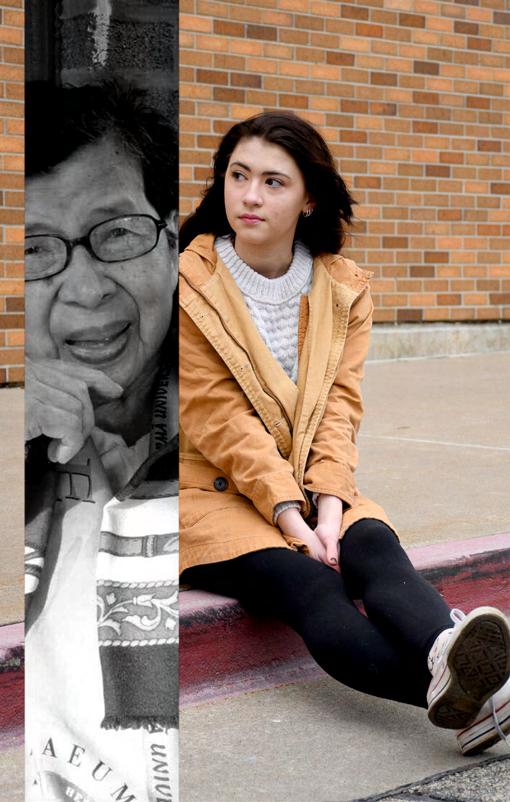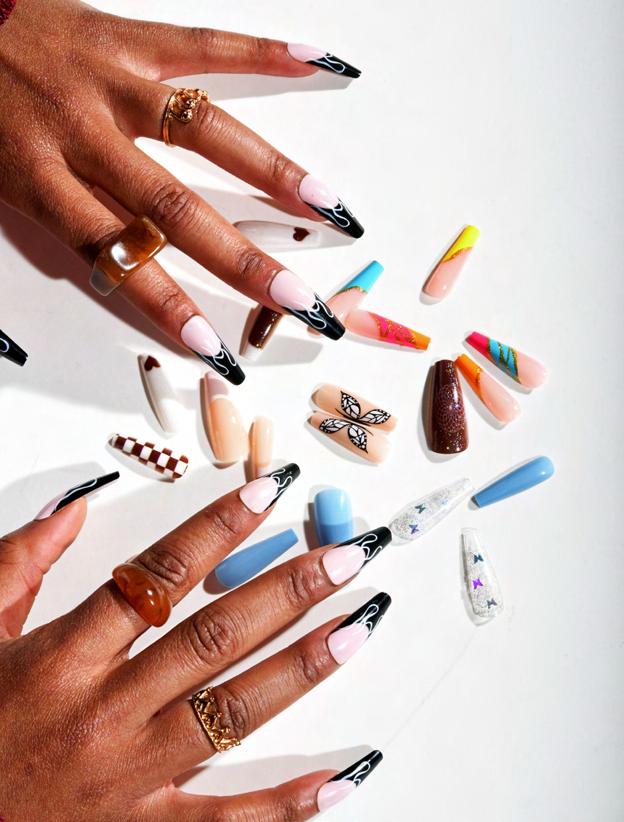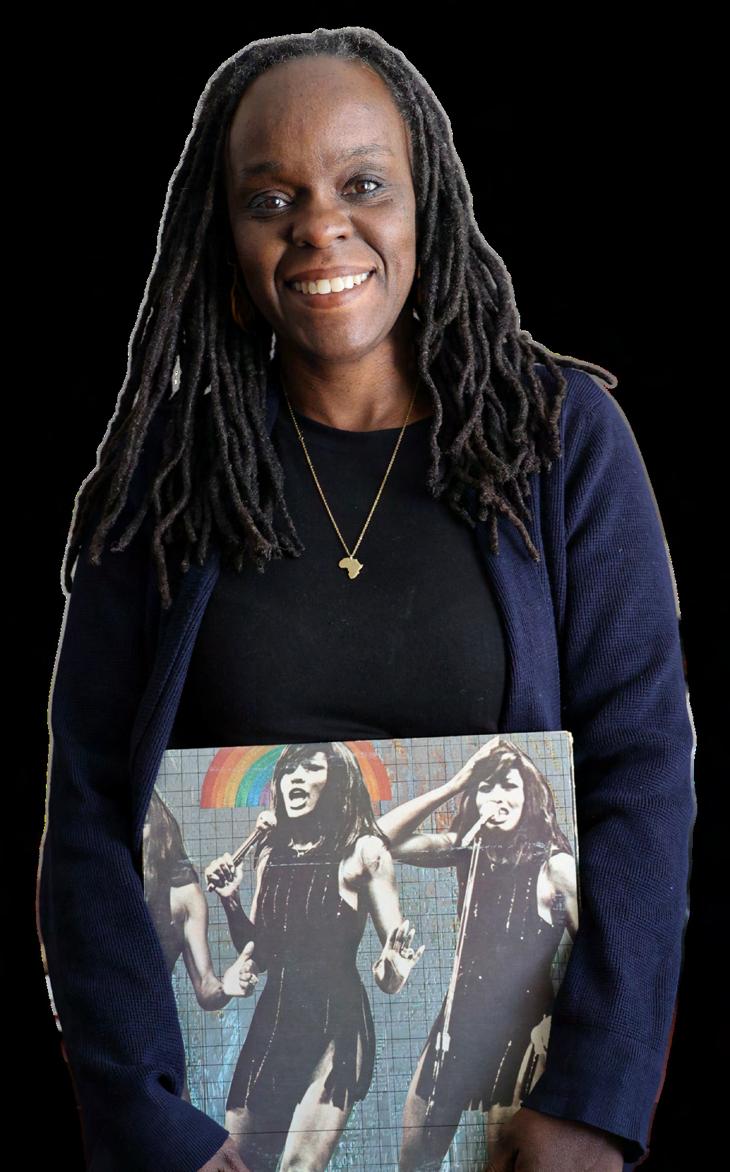When Charlie met Bettie
Over 75 years ago, their love story began. A photo essay documents their daily acts of love PAGE 18



Over 75 years ago, their love story began. A photo essay documents their daily acts of love PAGE 18


In early 2018, I received an international phone call. It was my parents relaying the news that my grandma had fallen and been rushed to the hospital. “Big deal,” she told my dad later from a private room in her retirement home’s medical unit. A few days later, I took a transatlantic flight home to Durban, South Africa, with goodbyes on my mind. When I saw her, Grandma squeezed my hand from her bed by the window with the light-blue curtains. Even though she couldn’t speak after the second stroke, I knew she recognized me. We bid her a final farewell after a few short days.
At her memorial service, the grief was palpable, but so, too, was my family’s commitment to celebrating her life — 86 years worth of cherished memories: yoga, day-long hikes in the mountains, homemade cookies and beach swims. Part of what I admired most about my grandma was her unconditional resolve to live. At 64, she hiked the Otter Trail, a 25-mile trek across South Africa’s most ragged coastal terrain and camped seaside for days at a time. At 75, she traveled all the way to the Galápagos Islands, and at 80, she was still body surfing with her grandchildren. Grandma was fierce, never
once letting her age dictate what adventure she could or couldn’t pursue. She taught us that life doesn’t stop when you reach a certain age. Research trends tell us that older folks are often portrayed poorly in the media, whether through negative framing or casting them as feeble. Ageism can take the form of employment and health care discrimination as well as invisibility, according to The New York Times And, often when ageism is internalized by older folks, it can lead to them having poorer physical and mental health.
This issue of Vox showcases a photo feature (p. 18) that illustrates the decades-long love story of a Columbia couple in their mid-90s who never stopped making plans or having fun. This story explores the lively dynamic between Bettie and Charlie and their relationship with the local community. Even at 94 and 95, the couple’s youthful spirit reminds us of what’s truly important in life. With the guidance of an incredible photo team, it is a privilege to bring you this story — one that celebrates life at any point along the journey. Alongside the legacy Bettie and Charlie are creating, my grandma showed me how to live life, and for that, I’ll always be grateful.
I’ve lived in Columbia for over 10 years. Although Asians make up just over 6% of the population, it has never felt like that to me. I spent my Friday nights at the Chinese church and my dinner plates were piled with fàn and cài. I’ve found a home in MU’s Asian American Association. After the Atlanta spa shootings, dozens of my peers gathered, tired and terrified. Yet our town let us down. Local media forgot us within days. Had we become invisible? I pitched this story because, readers, we are here. Asians and Asian Americans in Columbia are vibrant, loud and loving. We come from rich histories and are vital in bringing color to this city. In this issue, as we remember the lives lost in Atlanta last year, know that we still have stories to tell. — Moy Zhong
Amy Schaffer and Kevin Duong organized a March 19, 2021, vigil for the victims of the Atlanta spa shootings in Speakers Circle.

EDITOR-IN-CHIEF COURTNEY PERRETT MANAGING EDITORS EVAN MUSIL, REBECCA NOEL
DIGITAL MANAGING EDITOR GRACE COOPER ONLINE EDITOR HANNAH GALLANT
CREATIVE DIRECTOR MAKALAH HARDY ART DIRECTORS HEERAL PATEL, MOY ZHONG PHOTO EDITOR MADI WINFIELD
MULTIMEDIA EDITOR ANNA KUTZ ASSOCIATE EDITORS

CULTURE ALEXANDRA HUNT, ELIZABETH OKOSUN, JASHAYLA PETTIGREW, ABBEY TAUCHEN, MARISA WHITAKER
EAT + DRINK ISABELLA FERRENTINO, ANNA ORTEGA, LAUREN STONE, NIKOL SLATINSKA CITY LIFE KELSY ARMSTRONG, JANAE MCKENZIE, ZOIA MORROW, CEY’NA SMITH, OLIVIA SHEEHY STAFF WRITERS JESSE BERLIN, KARLY BALSLEW, JOZIE CROUCH, JOSIE HEIMSOTH, JACEY JOHNSON, ADRIAN MADDOX, AMILEE NUZZO, SYNDNEY SCALIA, MIKAELA SCHLUETER, MAX SHAPIRO, JORDAN THORNSBERRY, AUSTIN WOODS
EDITORIAL ASSISTANT BRADFORD SIWAK DESIGNER SHULEI JIANG
ASSISTANT ONLINE EDITOR OLIVIA EVANS
SOCIAL & AUDIENCE DOMINIC BOLT, EMMA DALKE, BRENNA ERWIN, DESTINY GARCIA, HAILEY KEENAN, BRYNN JANKOWSKI, MARIE MCMULLAN, CELA MIGAN
CONTRIBUTING WRITERS ATHENA FOLSERBRAZIL, ERIK GALICIA, JARED GENDRON, MALCIA GREENE, OLIVIA MAILLET, MELANIE OLIVIA, NATALIE SMITH, LUCY VALESKI, ABBY WHITE
EDITORIAL DIRECTOR HEATHER ISHERWOOD
EXECUTIVE EDITOR LAURA HECK
SENIOR EDITORS MADISON FLECK COOK, JENNIFER ROWE
OFFICE MANAGER KIM TOWNLAIN
Vox Magazine @VoxMag
@VoxMagazine @VoxMagazine
ADVERTISING 882-5714 | CIRCULATION
882-5700 | EDITORIAL 884-6432
CALENDAR send to vox@missouri.edu or submit via online form at voxmagazine.com
TO RECEIVE VOX IN YOUR INBOX sign up for email newsletters at voxmagazine.com

MARCH 2022
VOLUME 24, ISSUE 3

PUBLISHED BY THE COLUMBIA MISSOURIAN
LEE HILLS HALL, COLUMBIA MO 65211
Gotta catch ’em all: Pokémon card scalping amid the pandemic drove up prices of the beloved cards.



Vox captures one couple’s lifetime of love and laughter in photos.




Amid signs of spring in 2021, a March chill settled over all who gathered for a vigil to remember the victims of the Atlanta spa shootings on March 16, six of whom were Asian: Soon Chung Park, Hyun Jung Grant, Suncha Kim, Yong Ae Yue, Xiaojie (Emily) Tan and Daoyou Feng.
At Speakers Circle on the MU campus, attendees placed flowers and held signs to create a memorial for the victims. Close to 100 people held candles as speakers opened up about their experiences.
“It was very chilly, but I think that I was overcome with the feeling of heart warmth,” says Kevin Duong, an MU sophomore and organizer of the vigil.
“I don’t know how to describe that, but it was like an internal warmth. I saw a lot of, not just people, but kind souls.”
Kevin Duong’s parents run a nail salon in Mexico, Missouri. Duong organized a vigil with fellow MU students in Speakers Circle in March 2021(insert), and spoke of his fears for his family. “I couldn’t help but stress that maybe I couldn’t protect them because it’s out of my power, and all I can do is sit and watch as these people suffer,” he said at the vigil. This story was put together by women of Asian descent. Cela Migan is the internal vice president for MU’s Asian American Association. Amy Schaffer, the photographer, helped organize the 2021 Speakers Circle vigil. Moy Zhong pitched this story.
Duong and friends realized there would be no formal communication or
acknowledgment from the university administration about the shootings, so they organized a vigil, and news spread on social media and through word of mouth.

The energy was palpable, with individuals stepping up to share their stories and experiences as Asian Americans. For a vigil that lasted nearly three hours, time seemed suspended within the heartfelt intention and dedication of the attendees.
The spa shootings were the catalyst for smaller communities across the country to raise their voices and take action against the racism that had been building.
With the emergence of COVID-19 also came a rise in xenophobia on a national scale. Anti-Asian hate crimes increased by more than 73% in 2020, according to FBI data. Organizations like Stop Asian American Pacific Islander Hate work to address the rise

One year after the Atlanta spa shootings, the Asian and Asian American communities still reel from the collective grief and fear.
in anti-Asian hate crimes by providing information on what is happening now and a place to report incidents of hate anonymously online.
Candace Osborn was a senior at Rock Bridge High School at the time of the shootings and attended the vigil. Her reaction to the news of the shootings manifested itself physically.
“I felt really sick,” Osborn says. “I felt queasy; my stomach hurt when I read it because I had seen so many things previously with attacks on Asian Americans after the pandemic got really bad. When I saw that, I felt really unsettled because it could have been one of my family members.”
Across town on the night of the student’s vigil, candles also burned in front of Columbia’s City Hall at a different vigil. Organizers of the two events were unaware of each other.
“Many people have good ideas and good hearts and are saddened by such actions as occurred in the Atlanta area, so it’s heartening to see that people are taking their own actions,” says Jeff Stack, coordinator for Mid-MO Fellowship of Reconciliation and one of the organizers for the vigil at City Hall. “I’m not surprised the students pulled together.”
Many people, including the Rev. Hanjoo Park of the Korean First Presbyterian Church, came forward to share their stories at the City Hall vigil.
“We had some people sharing their experiences, folks of Asian heritage talking about what life is like in mid-Missouri, the bigotry they encounter,” Stack says. “That was really eye-opening, hearing about (their) first-hand experiences.”
What are mere stories for some vigil attendees are lived experiences for others. When reflecting on the anniversary of the shootings and the persistence of anti-Asian violence, life looks different for students, including Duong.
“I’ve been a lot more conscious of social problems,” Duong says. “Before college, I was like, ‘I think I can get by without being involved.’ Now after experiencing that and seeing how it actually affects people on a big scale, I can’t just sit around and not know anything.”
As many Asian Americans saw headlines confirming the rise in anti-Asian violence in 2020 and 2021, the media’s mishandling of the Atlanta shootings coverage felt like further disrespect and dismissal of the hate crime. This included failure to correctly spell or pronounce the names of the victims.

“I guess it wasn’t shocking, and that was the painful part about it — the fact that I was numb to what had happened,” says Jane Elliston, president of MU’s Asian American Association.
In the face of violence, discrimination and blatant racism against Asians and Asian Americans, MU students had to make calculated decisions about how to juggle this knowledge and continue with their everyday lives.
In sharing her experiences as an Asian American and being one-quarter Filipino, Osborn talked about the silence from her white peers, as well as the microaggressions and flat-out aggressions she faced at school.
“I felt silenced in a way because I didn’t hear any of my teachers talking
about it,” Osborn says. “Nobody at Rock Bridge said anything about it … at least in my classes, which made me feel like I couldn’t talk about it.”
Osborn’s Filipino immigrant great-grandmother died in October 2020, and she says she is glad her great-grandmother wasn’t around to witness the Atlanta spa shooting.
For Faith Carter, an MU sophomore, the shootings prompted a conversation with her parents about the reality of being Asian in America. Carter, who was adopted by a white couple, says they didn’t realize how visible their daughter’s race had become.

“I had to explain that when this happened, I felt very seen since the pandemic started,” Carter says. “Things are going on, but my parents were like, ‘It’s not that big of a deal.’ Then it became a big deal, and we had to talk about that.”
Other students had different experiences with their parents when discussing what was happening.
“I don’t think I ever talked to my parents about it,” says Wenxi Yang, an MU Ph.D. student and Chinese international student. “That’s the first piece because I am an international student here by myself,” Yang says. “My parents are back in China, and I think they probably have
read that news. I think they were probably very worried about me, but they never asked me about that news … because they don’t want me to feel more unsafe.”
Such events that live in the nightmares of parents and friends are happening, evident by the rise in hate crimes since 2020. For Asian Americans, this is happening to people who look like them.
While fear runs through minds, anger and exhaustion curdle in stomachs.
“There is anxiety that comes with knowing about (the shootings),” Elliston says. “It’s like terrorism against our racial group, and that comes with fear. I think a lot of anger came from our community, our side. And from the administration side, there was lack of empathy and lack of acknowledgment.”
For the Asian American community on campus, the radio silence from the MU administration felt like abandonment. When the administration did take action and release information, it was directed toward international students, Yang says.
The International Center held wellness workshops talking about discrimination, health during the pandemic and other related issues. However, the string of follow-ups and emails was difficult to keep track of. Eventually Yang stopped keeping up with the emails.
In the wake of the pandemic, anti-Asian hate and xenophobia, Asian Americans must confront a reckoning with their identities and how they choose to portray themselves and share their culture.
“Before the pandemic, there (was) definitely discrimination based on what I look like,” Yang says. “But I never felt the need to reflect on my personal identity. After the pandemic, it took a toll on me. I really started to think about ‘What does it mean? What does it mean to me, being an international student in the U.S., and what does it mean to be an Asian American in the U.S.?’ ”
Asian Americans communities are rallying support and offers an influx of love, such as with the hashtag #VeryAsian.
To be “very Asian” in a country that seems very anti-Asian can feel alienating. However, embracing one’s identity and culture can be a source of great strength.
Jane Elliston visits Speakers Circle, the site of a 2021 vigil. Elliston is the president of MU’s Asian American Association (insert), which lead the vigil.
“It has given me more of a willingness to say when I feel like things aren’t OK, when I feel like people are saying things to me that are inappropriate,” Osborn says. “It’s not necessarily the people around me changing, but it’s the part of myself that’s changing, and I think that I can appreciate that now.”
Candace Osborn revisits Rock Bridge High School. When the Atlanta spa shootings happened, she was reminded of her great-grandmother Maria Gotangco (insert), a Filipino immigrant who died in October 2020.

“I’m so heartbroken that she’s not here anymore, but I’m so glad that she doesn’t have to read or see any of these things in the news,” she said in 2021.
As these unprecedented instances of anti-Asian hate have become the unfortunate new normal, many Asian Americans are re-evaluating their identities and adapting to a world where anti-Asian hate crimes are on the rise.
It’s been one year since the Atlanta spa shootings. In the time since, countless instances of racism, hate crimes and violence have terrorized members of the Asian American community. Many of them are reevaluating their identities and adapting to a new world. One year from now, it’s hard to say what change will have been made and what events will have transpired. Will we be remembering yet another tragedy?
Each month, Vox curates a list of can’t-miss shops, eats, reads and experiences. We find the new, trending or underrated to help you enjoy the best our city has to offer.
BY KELSY ARMSTRONG

On food from a couple Columbia eateries that are on the move. Big Daddy’s BBQ is opening a second location on Paris Road in December. They’ll continue to serve barbecue staples in addition to soul food with indoor dining options and alcoholic beverages year-round. Longtime west-side Bamboo Terrace will be moving downtown. The Chinese restaurant is taking over the space at 26 S. Ninth St., where the International Café served up Mediterranean cuisine for 32 years. Co-owner Celeste Chen told the Missourian they hope to open in March and will offer takeout only for the first few months. Big Daddy’s BBQ, 1802 Paris Road and 1209 N. Garth Ave, 11 a.m. to 7 p.m. Wed.–Sat.; Bamboo Terrace, 3101 W. Broadway, 11 a.m. to 2:30 p.m. and 4:30–9:30 p.m. Wed.–Sun.
At the January Lanterns album release party at The Blue Note. Columbia locals Andrew and Kristen
Hasan Minhaj when he comes to Columbia March 17 with his new show The King’s Jester. After a four-year hiatus from comedy, he is returning to his storytelling roots. You might recognize him from his 2017 Netflix comedy show Homecoming King or his other show Patriot Act with Hasan Minhaj Minhaj is an American comedian, writer, political commentator and television host. Missouri Theatre, March 17, 7 p.m., tickets start at $49

Along Sinkhole Trail, and take a breath of fresh air. You can enjoy a springtime jaunt at Rock Bridge Memorial State Park, which has history that dates back to the 1800s. As you hike, you learn a quick lesson through a series of 15 laminated photos from the past. The photos tell the story of the park’s founding, Rockbridge Mills and more. You can also request a copy of the images by emailing rockbridgememorialstatepark@ dnr.mo.gov. Rock Bridge Memorial State Park, 5901 S. Hwy. 163, sunrise to sunset


The newly renovated Sager Reeves Gallery. The gallery was renovated in January and opened to the public in February. With a new layout, the renovation offers two new display walls. Rather than the previous five showcased artists, the gallery will now have three artists’ work on display. Sager Reeves Gallery, 1025 E. Walnut St. 11 a.m. to 6 p.m. Tues.–Sat.

Press-on nails are now joining claw hair clips, platform sneakers and wide-leg bottoms on the list of reemerging trends. The popular ’70s and ’80s trend was given new life in 2020 when nail salons had to close due to the pandemic.
This nail craze was once considered tacky and cheap because many buyers didn’t know how to properly apply the nails, and there weren’t many cool designs.
Now, though, pressies are all the rage in the nail and fashion industries. From classic French tips to funky designs with 3D art, there’s something for everyone. According to beauty and fashion-focused media brand Glossy, Google searches for the nail trend grew by 32.2% from June 2020 to June 2021.
Madison Thompson, a textile and apparel management minor at MU, says more businesses are stocking their shelves with press-on nails. This trend was starting to take off even before COVID-19 restrictions were instated. In 2019, Vogue Business reported that big retailers like Target and Ulta had seen growth in press-on nail sales.

“There are also some small businesses on Etsy that have started selling a lot more because of the new market for wanting press-on nails with more intricate nail designs that are more of a trend right now,” Thompson says. A quick Google search will show you a variety of styles, including but not limited to rhinestone-accented nails, holiday-in-

Rethink booking that nail appointment. Press-ons are back.
spired sets and animal print pressies.
Maya Robinson is one of many beauty connoisseurs who decided to take matters into her own hands and launch a business selling pressies. Inspired by the ease of press-on nails, the Columbia-based creator opened her Etsy shop, Angel Nails by MayasDreamHouse, in December to add some glamour and flair to people’s lives. “I like having lots of things around that make life easier and more convenient,” Robinson says. Applying press-ons at home is less of a time commitment than sitting down at a salon. “That was literally inspiration for me.” A fresh set from Angel Nails is $10.
St. Louis-based makeup and nail artist Montia Evans agrees that the convenience of pressies is a driving factor for clients. “I feel like they’re really coming back for the modern young woman or young adult who’s always on the move,” she says.

Evans designs her press-ons with intricate art and graphics that can take up to four hours to create and cost beSave

tween $20 and $75 per set. Her clients love the charm her designs add to the nails. “It’s the bling,” she says. “They love anything super flashy, bright. They like to stand out.” Potential clients can place custom orders through Evans’ Instagram, TaggedByTia.
Heaven Quinn, a client of Evans, says she likes how the artist puts her own twist on the nails. “She always brings my vision to life,” Quinn says. She chooses press-on nails over other nail fads because of the ease and uniqueness. “They feel just like if I went to the nail shop.”
Many popular nail-care companies, such as Olive & June and L.A. Colors, have begun selling press-on related items such as remover, glue tabs and oils. Olive & June advertises its press-on nail supplies as being non-damaging, non-toxic and made from 94% post-consumer recycled materials.
Furthermore, press-ons are becoming a sustainable alternative for chic nails because, with the right care, most pressies can be reused. Glue tabs are per-
fect for those who just want a press-on manicure for the day or a night out but don’t want to commit to a two-week set. Unlike stone-washed jeans, nail wraps and cold-shoulder tops, press-on nails are a trend that conquers obstacles like affordability and sustainability — and they might be here to stay.
Professor and ethnomusicologist Stephanie Shonekan explores the history of cover songs and the neglect of Black songwriters on a new KBIA podcast.
 BY JOZIE CROUCH
BY JOZIE CROUCH
The practice of artists covering one another’s work extends as far back as the classical music era and originated as a way for people to pay tribute to those they admired in the field.
“But then when money got involved, particularly when they’re in the recording industry in the ’40s and ’50s, it became pretty rampant,” says MU School of Music professor Pete Zambito. “They tended to be white artists stealing from Black artists.”
A cover song is a new performance by a musician other than the original composer of the track. Did you know Elvis wasn’t the first performer of “Hound Dog”? Blues legend Ellie Mae “Big Mama” Thornton actually performed it four years earlier.
Associate Dean of the MU College of Arts & Science Stephanie Shonekan is providing her own takes surrounding the culture of covers. “As an ethnomusicologist, I study music,” Shonekan says. “I study the ways in which music is created and what it’s created for and how it functions in society.”
Cover songs are still prominent in the entertainment industry in a variety of forms. Hit-singing competition shows like The Voice and American Idol are built on covers of beloved songs. Newspapers relay frequent headlines about plagiarism lawsuits following the industry-shaking 2015 case in which Marvin Gaye’s family successfully sued Robin Thicke and Pharrell Williams for copyright infringement in their song “Blurred Lines.”
In KBIA’s new podcast, Cover Story, Shonekan will interview a guest each week and dive into the context and artistry of iconic cover songs and their originals.
What was the inspiration behind the podcast?
The choices that artists make are grounded in their understandings of the world and the meanings they want to make in the music. In short, I was inspired to
think about covers because I’ve always liked to pay attention to what artists do. I thought it would be fun to ask, “Whose is better?” There used to be a (section) in People magazine where they would have two people who wore the same dress or the same outfit and they’d ask, “Who wore it best?” That’s kind of the impetus for the concept for this podcast.
How do cover songs explore larger themes such as race and gender?
I do use cover songs as a device to analyze issues of racism and sexism and so on. For example, there’s a song that Nina Simone did called “I Wish I Knew How It Would Feel to Be Free.” Later on, it was covered by people like John Denver and Mary Travers. It’s a beautiful song, but when they cover it, is the freedom they seek the same freedom that she’s singing about? It was written by Billy Taylor during the civil rights movement, so the concept of freedom from different angles is interest ing. It helps us think about some really deep aspects of the human experience.
What are your thoughts on covers in the context of plagiarism and lawsuits?
I think that the history of African Amer ican artistic expression — whether that’s art or music — that history has been mired in stealing. If we go back to blackface minstrelsy, we know that African American performance was appropriated. When people profit off of the exaggeration of Black performance, that history is difficult to look away from. For so many years, people were making money off Black music, Black dance, Black gestures — and Black people were not making money off of it. When we fast forward to those cases now, we have to think about the capitalism that shrouds the creation of new forms of music from old
Listen to music professor Stephanie Shonekan debate some of music’s most legendary performances. All episodes will be available in March via KBIA’s website or wherever you listen to podcasts. The first episode addresses the Prince and Sinéad O’Connor versions of “Nothing Compares 2 U.”
ones. My view is that if you’re going to use somebody’s work, get their permission and compensate them for the use of the work.
What can listeners expect from your podcast?
Listeners can expect fun and curiosity and a little competition — a little debate over who did it best and why. These are big, iconic songs that we know and love. (Some listeners) may not agree with the take that either myself or my guests have on who did the song better. I hope that listeners expect to come and be surprised. Come and be inspired to talk and to throw shade on the take that comes










As the pandemic raged, Pokémon enthusiasts struggled to catch any cards at all.











 Story David Neumaier
Photography Owen Ziliak
Design Shulei Jiang
Photography courtesy of vrrroomvrrroom/Reddit
Story David Neumaier
Photography Owen Ziliak
Design Shulei Jiang
Photography courtesy of vrrroomvrrroom/Reddit
Walking into Target and looking to rediscover an old hobby, Laine Friedrich found a gaping hole on the shelves where Pokémon cards used to be in the large aisle right by checkout. The Yu-Gi-Oh and Magic the Gathering cards in the area surrounding the hole were in disarray, a sign of a struggle or something else passing through and sweeping away the hope of reliving a memory.
Scalpers, supply chain delays and the impact of influencers all drastically increased the cost and demand of Pokémon cards. With these factors combined, it was a perfect storm.

The first Pokémon cards were printed in October 1996, eight months


after the franchise’s first video game installment. Jeremy Aaranson, card salesman and head buyer at Valhalla’s Gate, a local Columbia game store, calls them “luxury cardboard.” They can be collected and gain value over time, or they can be used as the main component of a trading card game. With attention drawn elsewhere during the advent of the Pokémon video games, many cards collected dust. In March 2020 when COVID-19 lockdowns went into place, there wasn’t much to do. Some would call their friends and play video games remotely, but even with all those planned activities, there was still plenty of time spent bored in the house.
That was the first blow.
“What do you do when you can’t leave your house for a couple months?”
Aaranson asks. “You look through your closet. What do you do when you go through your closet? You find your old cards from 10 years ago when you were a kid, and you start feeling nostalgic.”
But there was another problem at hand. With everything shut down, there were no tournaments or events. There was no way to play or show off the cards as a collector. Strapped for cash, some turned to the internet to start selling their cards.
Although Aaranson wasn’t in desperate need, selling cards was his job.
He was used to traveling to Japan once a month to get cards. But when he, too, was stuck at home with no way to refresh his supply, he had to rely on buying directly from his distributor. Aaranson has 2.5 million Pokémon cards that he keeps in a warehouse and sells on Amazon and the online trading card store TCGplayer.

Influencers such as Logan Paul began taking advantage of the newfound supply from nostalgic collectors. On Oct. 3, 2020, the influencer with over 23 million subscribers on YouTube released a video entitled “I Bought A $200,000 Box Of Pokémon Cards.” The video garnered nearly 9 million views, intensifying nostalgia and increasing demand for the cards.
Brian Holt, manager at Columbia game store Magelings, saw the warning signs and predicted a shortage. “We normally keep a large backstock of older sets, and it started selling very quickly,” he says. “Usually, Pokémon cards are only printed for a little while, and then they move on to the next set. So backstock is pretty much impossible to get, unless they reprint.”
Seeing all the backstock sell was a harbinger for Magelings Games, and the store wanted to buy more cards to keep up with the increasing demand.

Pokémon is a Japanese media franchise founded in 1996. Its primary components are a trading card game, a video game series, an animated TV series and a major motion picture. Over 34.1 billion Pokémon cards have been sold worldwide. In the franchise, Pokémon (short for “Pocket Monsters”) are elemental creatures that human trainers collect and train to battle other Pokémon for sport.


The series was inspired by founder Satoshi Tajiri’s love of collecting insects, and there are over 890 Pokémon species, according to the Pokédex database. The trading card game mimics the battles between trainers in the video game.
Collectors, players and traders continuously purchase cards to grow their collections, gain strength in battle or increase trading stock. There are many ways to purchase Pokémon cards.
Pre-made decks. These are packs of 60 cards designed to go together, ready to shuffle and play with.

Booster packs. These are packs of about 10 miscellaneous cards, typically found in retail stores. Elite Trainer Boxes. These cases contain eight booster packs, along with additional collectible items for playing the game.
Build & Battle Kits. These are the first to be released with a new set of cards. They come with four packs of cards, a code that translates to the online version of Pokémon and 23 random cards that might help trainers build their decks.
Booster Boxes. These contain 36 individual packs. “These are probably the most popular thing that people buy,” Magelings Games employee Ryan Elkins says.
However, Pokémon card distributors allocate the product instead of allowing stores like Magelings Games and Valhalla’s Gate to buy as much as they need.

“So if you normally get two cases of something, they’re going to assume that you’re going to want two cases,” Holt says. “If you suddenly say, ‘I want 14 cases,’ they’re going to go: ‘Calm down. You get two. The guy who gets 14 every time gets 14.’
“A while back, I wanted 80 or 100 boxes of these elite trainer boxes,” Holt says. “And I got 10, and they were spaced out over four different shipments.”
When nostalgia meets market forces
Pan Zheng, 18, a senior at Hickman High School, had a job and was making a little bit of extra money. He rediscovered his love for Pokémon cards in February 2021, around the same time Shining Fates, a highly desirable Pokémon set, was released. Zheng went to Walmart to find some cards. Luckily, he found an Elite Trainer Box for the set Crimson Invasions, a set he now calls “super bad.” That is why, he says, the box was still on the shelf amid the frenzied buying of other cards. He considers himself fortunate to have found Elite Trainer Boxes.
Friedrich, a student at MU, was not as fortunate. He has been collecting cards ever since he was a kid, and when the nostalgia hit him, he started looking for cards again.
“I was a little too late,” he says. When he went to Target and found the gap on the shelves where the Pokémon cards used to be, he was disappointed. “I was bummed it just wasn’t there.”

He eventually found a 10-card booster pack over the summer and bought it just because he could. “It makes you feel the feeling of being a kid again,” he says. “I hope I can buy more later.”
Shining Fates was where the real shortages started coming into play as people stole and fought over the boxes in stores across the country, Aaranson says, “Because it turns out, not everyone is (an adult). They may be old enough to be an adult, but they do not act like an adult.” In May 2021, U.S. Target stores temporarily halted sales of Pokémon cards out of an “abundance of caution,” according to a statement given to comic and gaming website Bleeding Cool. Local game stores soon realized what they were up against and responded by limiting how many cards each person could buy.
“Someone tried to rob us of Pokémon cards,” Magelings Games employee Bryan MacKenzie says. “The good news is we didn’t have any.” Fellow Magelings employee Ryan Elkins says the store sold out of Pokémon cards two months after the Logan Paul video and had no cards in the store for four months.

When Magelings finally did restock, the store would initially limit customers to just two boxes at a time. Holt had some Pokémon products that were supposed to last a week, but they sold out in a day and a half.
“I put a limit on it so people can’t just buy them all at once,” he says. “You make the same amount of money selling them all to one person or 70 people, but when the play starts up again, one person can’t play in a tournament.”


Magelings Games hosts tournaments for Pokémon card battles. Al -

though the store had to stop them for months during the height of lockdown, it is getting back into it.
Trading card games have a few ways of assessing the value of cards. One is its playability, and because not many tournaments were active, the playability of older cards started to decrease. “If the card was worth 10 bucks because it can win you a game, and you’re not playing the game, it’s not worth 10 bucks anymore,” Holt says.
The government also had its own (unintentional) hand to play. Holt says that when the stimulus checks started being sent out, his customers who were not struggling were able to use that money to buy more cards. “People like to buy happiness, and we sell it,” Holt says. With a business license, they could participate in allocation and get cards for wholesale prices. “So you spend a couple hundred dollars to get a business license,
Johnathan Mallott keeps his Pokémon cards in binders.

Pokémon cards were first produced in 1996 and have since exploded in popularity.


Getting Pokémon cards graded is a helpful indicator of the cards’ value. The most strict grading company is Beckett Grading Services (BGS). Cards are evaluated on their upkeep, including centering, corners and edges. For instance, if a card with a popular Pokémon, such as Charizard, gets an total average of 10 points, it gets a gold rating. A black card is a perfect card with 10 points per category. A black card is often worth much more than a gold or nongraded card.
Professional Sports Authenticator (PSA) is used a little more than BGS for grading cards, but it does not have the same authority. “A BGS 10 Charizard will go for at least $250,000, but a PSA 10 Charizard will go for less,” Pan Zheng says.
and you save several thousand dollars on your cards,” Holt says.
Those who bought a business license started running what Holt calls “basement” stores that only exist on the internet. Allocation kept these stores from taking away too much from brick-and-mortar stores, but they were still able to spread the market even thinner as owners tried to take advantage of the high prices.


Another part of buying and selling cards, particularly rare or valuable cards, is getting them graded. Companies such as the Professional Sports Authenticators (PSA) and Beckett Grading Services (BGS) assess the cards’ value. As popularity surged and more cards started to get graded by these companies, they got overwhelmed.
The companies started increasing how much it cost to send in cards to get graded. BGS raised its cost to $250 per card in a failed attempt to slow down the demand for card grading. Then the grading companies stopped accepting cards altogether.
At the end of March 2021, PSA wrote in a public release, “We recently received more cards in three days than we did during the previous three months.” The company halted several services to catch up.
PSA’s services didn’t resume until July 2021. In June, BGS also instituted a temporary halt in card-grading services. The delay from the grading companies became a choke point for cards, sometimes taking 400 days to return cards to their owners after being graded, Aaranson says. The record delay for Valhalla’s Gate was 473 days.
“So you removed an enormous amount of high-end cards to get graded,” Aaranson says, “Which means that on top of people not being able to get product, on top of vendors not being able to get product, on top of customers and collectors not being able to get product, a massive amount of the inventory disappeared for a year to be graded. So you add artificial scarcity on top of actual demand on top of actual scarcity.”
All of these winds blew into the perfect storm, and as a result, prices of Pokémon cards soared. By the end of 2021, the prices for sealed Booster Boxes approached 10 times the manufacturer’s suggested retail price, or MSRP, from 2019.
For some time, the 25th anniversary set, Celebrations, had an Elite Trainer Box valued and sold for $100, where the suggested price was about $50. “MSRP has become a joke with Pokémon,” Holt says.
Now, the Pokémon Company has finally managed to produce significantly more cards to the point where some of the 25th anniversary sets can still be found on shelves. However, the newest sets are still facing shortages.
As the storm subsides Aaranson has high hopes that the scalping is on its way out. “There were two or three well-known scalpers in my area that basically tried to cash out at a loss because they weren’t a brick-and-mortar store,” Aaranson says.
A brick-and-mortar store offers something scalpers can’t. Something crucial to the fun of the game: a place to play.
As the market began to stabilize, Magelings Games started to institute card purchase limits on a case by case basis, trying to use their best judgment to spot a scalper.

“Some grown adult would come in and say ‘Hey, how much Pokémon you got?’ and we’d say: ‘No. Those are for children,’” MacKenzie says.




The market might never be the same, but even as prices go down, Aaranson says the market’s investment dollars are not drying up but are being replaced by those who care about the game. Local game stores are doing their part to preserve the game for them.
MacKenzie says, “If a kid came in and the parent was like, ‘He saved up all his nickels and dimes to buy a case,’ we’re probably more likely to give that away than to a guy who’s going to chop it up and sell it on eBay.”

Idon’t cook. I don’t clean. I am not like my mother.” This was Bettie Chester’s reply to Charlie Koelling’s marriage proposal in 1946.
Charlie and Bettie grew up together in New Franklin, and Charlie was smitten with Bettie at a young age. “From afar, I admired her,” he says.
Charlie served in the Navy during World War II, and when he returned in April 1946, Bettie was engaged to his best friend.
“He was not my best friend,” Charlie insists firmly.

“Well, not now,” Bettie says with a smile.
Four months later, they married in an intimate five-person ceremony on Aug. 5, 1946. A week later, they had a wedding reception at the home of Bettie’s parents.
It has been 75 years since Bettie and Charlie got married — 75 years full of love, family and memories. They have two children, four grandchildren and five great-grandchildren.
Even at ages 94 and 95, their spirits remain young. Now, they have spent over 27,000 days of their lives facing challenges together and cherishing each other’s dreams and aspirations.
Take a glimpse into the love story of Bettie and Charlie Koelling — over 27,000 days in the making.
“It might not look like it, but we are having a lot of fun,” Charlie Koelling says while holding Bettie’s hand. The couple got married when Bettie was 18 and Charlie was 19. Charlie says the secret to a happy marriage is saying, “Yes, dear!”
Charlie plans his next move in a game of two-person bridge — a game modification the couple came up with. “We never argue,” Bettie says. “We have disagreements, but we just agree to disagree.”


Bettie and Charlie exercise at the gym at Lenoir Woods Senior Living Community where they live. They enjoy doing activities together. When they were young, they had a family tradition of making chocolate fudge for Christmas. The tradition is now kept alive by their daughter, Karen Weaver.

Bettie clasps Charlie’s hand. “We’ve had a wonderful life together,” she says. “We didn’t have big, expensive stuff, but we had a lot of fun.”

Charlie performs his weekly ritual of refilling Bettie’s medicine box. The couple expresses their love by taking care of each other. Years ago, Bettie decided to work and financially support their family so Charlie could pursue his Ph.D. “People were surprised and questioned my decision,” Bettie says.



Vintage cookbooks tell stories of the past through unexpected ingredients and nostalgic dishes. Jell-O and Cheez Whiz were often in the recipes of older generations.


Vintage cookbooks bring back a taste of history, including a few recipes we’d rather forget.
BY RASHI SHRIVASTAVA

When thumbing through the dog-eared, crinkly pages of a vintage cookbook, one can expect to stumble upon absurd and intriguing finds. From household tips about how to get rid of bugs to medicine for the common cold (including the classic hot toddy), antique cookbooks are historical and contemporary gold mines.
Cookbooks originated from the family recipes of European colonizers. Magdalene Linck, a library assistant at the Missouri History Museum, says one of the earliest cookbooks published in Missouri was Julia Clark’s Household Memorandum Book. The cookbook, published in 1820, offers an inside look into the lives of a famous Missouri household — that of William Clark of the Lewis and Clark expedition.
“She has handwritten recipes that are kind of thrown in amongst recipes for how to remove certain types of stains from fabric, how to polish silver, proper etiquette and household management techniques,” Linck says, who has a vast collection of historic cookbooks.
One of the most popular cookbooks to come out of Missouri is Joy of Cooking by Irma Rombauer of St. Louis, published in 1931. Several million copies of the 1975 edition were sold, and it soon became a standard in many American kitchens. The book, which gained popularity for its conversational tone, included recipes for classic American dishes such as chicken à la King (diced chicken and vegetables in a rich cream sauce) and molded cranberry nut salad.
“The ’60s or ’70s edition has a fantastic illustration of instructions on how to skin a squirrel and prepare squirrel meat,” Linck says. “It’s a very cheeky little illustration that is quite graphic.”
Along with instructions for classic dishes such as custards and pies, some cookbooks come with overly basic and bizarre recipes, Linck says. For instance, one cookbook includes recipes for toasting bread and boiling water. Some peculiar recipes include a broccoli casserole that uses an entire can of Cheez Whiz, a molded Jell-O salad made with cherries and Coca-Cola and a spaghetti casserole covered with deviled ham.
During the world wars, cookbooks such as The Patriotic Food Show Official Recipe Book, Grandma’s Wartime Kitchen and Approved Enduring Favorites encouraged Americans to use less meat and fatty foods so those could be sent to the troops, which resulted in a buffet of vegetarian cookbooks.
These wartime cookbooks included recipes such as mixed vegetable soup stock, oat bread and cornmeal wheat biscuit. The culinary manuals required rationing of certain ingredients, writes Carol Fisher in Pot Roast, Politics and Ants in the Pantry, her book about Missouri’s cookbook heritage.
“It records the progression of food history because generally, in those cookbooks, it was a reflection of what they were actually cooking in their homes,” Fisher says.
While documenting societal changes and the foodscape, church and community cookbooks also record ethnic and immigrant history. German-Missouri Cookbook of “Duden Country,” published in 1992, details the extensive German influence in Missouri kitchens. Other cookbooks capture the historic stories of famous eateries that have since closed, such as The Blue Owl Restaurant in
This 1949 cookbook was featured in the St. Louis Star-Times Cookbooks have been influencing Missouri kitchens since the mid-19th century. Over time, these guides have consisted of nostalgic cuisines that might seem unusual by today’s standards.

Kimmswick, Stephenson’s Apple Farm Restaurant in Independence and Miss Hulling’s Cafeteria in St. Louis.
Black cooks were predominant in Southern kitchens. Despite this, there are few vintage cookbooks that acknowledge their presence and talent, says Colorado-based food writer Adrian Miller. He has researched Black cookbooks and the role of Black chefs in food history. In 2021, Miller published a book called Black Smoke: African Americans and the United States of Barbecue about the absence of African American narratives from barbecue culture.
If you want to bring a vintage vibe to some of your dishes, try swapping out ingredients for some throwback foods. Dip veggies into a fondue of Cheez Whiz or add dry Jell-O to cake mix for a denser texture and extra flavor.
“Black cooks dominated a lot of kitchens because that was one of the few professions that African Americans could pursue,” Miller says. “And that tied into this racist notion that Black people were designed for servitude.”
One of the few Missouri cookbooks that represented Black cooks’ contribution to culinary history is called The Ideal Bartender, published in 1917 and written by Tom Bullock, a bartender who worked at the St. Louis Country Club.
Whether it’s a recipe and diagram for preparing squirrel meat or the original pound cake recipe, which remains practically unchanged for 200 years, vintage cookbooks offer tiny bites and sweet treats for the contemporary culinary crusader.
“Specifically, in terms of food insecurity, (microgreens) could provide a nutritious option when fresh produce is less available or if an individual does not have much storage space for fresh produce,” Harrison says.
There are no restrictions when it comes to eating microgreens, Stem says. “I don’t know about a peanut butter and jelly sandwich, but for the most part, they’re a great addition to anything.”
Stem suggests tossing microveggies on tacos, scrambled eggs and sandwiches, and Cabrera-Garcia says he enjoys substituting microgreens for lettuce on his burgers. “They are really flavorful, and I feel it is like having the flavor of the full plant in a single microgreen,” Cabrera-Garcia says.
Local health and horticulture experts explain why these baby plants are worth a try — both for growing and consuming.
BY JARED GENDRONAt first glance, microgreens might seem like a garnish for salads, soups or other savory meals, but these inch-tall baby plants are worth trying for many reasons. For one, they’re densely packed with nutritional value.
The small greens are grown using seeds from the same plant families that broccoli, lettuce and many other vegetables come from, and this lineage determines how they taste.
In Columbia, Stem to Table Farm supplies local restaurants and grocery stores with microgreens. Co-owner Clay Stem, who has been running the farm since 2017 with his wife, Jen, also sells them at the Columbia Farmers Market. At the back end of his house, Stem can be found toiling away, producing the superfood he has been eating consistently for more than four years.

“We call them ‘tiny but mighty,’ ” Stem says. “That’s kind of our tagline we like to use because they’re up to 40 times
more nutritious than their full-grown counterparts.” This can be attributed to microgreens’ high levels of minerals and antioxidants.
Microgreens also contain a higher concentration than mature greens of phytonutrients, which are health-benefiting compounds in fruits and vegetables, writes Juan Cabrera-Garcia in an email to Vox. Cabrera-Garcia is an MU Extension horticulture specialist and assistant professor at the University of Missouri-Kansas City.
Farmers such as Stem, who grows plants in a sunroom, can produce microgreens indoors and harvest them yearround. Compared to full-grown vegetables, the small greens are more beneficial for resource management, writes Liz Harrison, an MU Extension nutrition and health education specialist, in an email to Vox
She says less water and space is needed to produce a sizable amount of tiny greens compared to full-size vegetables.
Stem to Table Farm provides microgreens for local grocery stores. Shoppers can pick some up at EatWell, Clovers Natural Market and all three Columbia Hy-Vee locations.

Stem and Harrison say blending them in a smoothie isn’t a bad idea; slurping a drink containing microgreens instead of full-grown veggies helps avoid the dreaded “green thing in your teeth,” Harrison points out.
Even with all these positives, growing microgreens remains a demanding task. Stem can easily spend up to 70 hours a week managing his plants. Despite it all, he loves the work.
“I think for so long, we just go to the store and buy whatever’s on the shelf,” Stem says. “But I think people ... are open to (trying) and wanting to trust the person that provides them with their food.”
Sprinkle fun and flavor into your breakfast routine with these three local doughnut shops.

 BY ADRIAN MADDOX
BY ADRIAN MADDOX
Doughnuts are a classic breakfast staple for those on the go. With the closing of Harold’s Donuts in August 2021 and Yummy’s opening this spring, Columbia has had several changes in the doughnut scene. Give these three shops a try to bring some morning sweetness into your life.
NEW IN TOWN: YUMMY’S
200 N. Providence Road; Tues.–Thurs., 6 a.m. to noon, Fri.–Sun., 6 a.m. to 1 p.m.; 355-7364
Kim and Linh Nguyen are expanding from Yummy’s Donut Shop in Boonville and are planning to open Yummy’s in Columbia this spring.
The new shop will have the same menu as its Boonville location, offering a variety of cake, glazed and specialty doughnuts. Yummy’s also sells hot coffee, tea, muffins and other breakfast goodies.
Drue Watson is a frequent customer at the Boonville location. “Those doughnuts are my kryptonite,” Watson says. “Every time you go in there, they are very personable.”
Must-try flavors: cinnamon twist, filled long johns and sprinkles
including the sprinkled selections above and below are made fresh daily and served in decorative white or pink boxes that read “You deserve a donut.”
COLUMBIA STAPLE: DONUT D-LIGHT
1301 Vandiver Drive and 3301 W. Broadway Business Park Court; daily, 6 a.m. to 4 p.m.; 814-2304
Cindy and Kevin Hicks have been serving Columbia old-fashioned doughnuts at Donut D-Light since July 2010. At both locations, guests can enjoy freshly made doughnuts including classic and unique flavors such as blueberry old-fashioned, cherry chip and chocolate cake.
Donut D-Light showcases its old-fashioned and glazed doughnuts, but the menu also includes jelly-filled doughnuts, cinnamon rolls and danishes as well as savory options such as croissants and kolaches. The location on West Broadway sells fruit tea and milk tea with boba as well as smoothies. The doughnuts and other breakfast pastries line the walls, providing many options for customers to choose from. Both locations might close early depending on when they sell out, so be sure to visit before noon to secure your doughnut.
Rebecca Acton has been a loyal customer of Donut D-Light for more than seven years. “What I appreciate is that their doughnuts are always fresh,” she says. Must-try flavors: apple fritter, bismarkfilled and yellow cake
1105 Grindstone Parkway; Mon.–Fri., 5 a.m. to 2 p.m., Sat.–Sun., 6 a.m. to 1 p.m.; 442-5608
Ellianna’s Donut Shop opened its doors in October 2020 after moving from Boonville to Columbia. Owner Talo Mam named the shop after his daughter. Customers can order inside or via the drive-thru.
Ellianna’s serves glazed, cake and specialty doughnuts that look as good as they taste and stay airy throughout the day. Guests can also choose from croissants or biscuit breakfast sandwiches to conquer their savory cravings.
The center of attention in the shop are the large pink cases filled with fresh doughnuts, providing a perfect opportunity for an Instagrammable moment with your strawberry-glazed or sprinkled doughnut. These doughnuts sell out quickly on weekends, so consider visiting before 8 a.m. to get your pick.
Tennille Lester, a frequent customer of Ellianna’s, often takes her 3-year-old daughter into the store to pick out a doughnut from the large display cases. “We absolutely love the freshness and friendliness that they have at the shop,” she says.
Must-try flavors: maple bacon long john, cake doughnuts and bear claw
Local artisans join under the collective Cre[8] brand to support one another and connect with buyers.

 BY ADAM HEALY, HALLE JACKSON, ABBY WHITE AND MOY ZHONG
BY ADAM HEALY, HALLE JACKSON, ABBY WHITE AND MOY ZHONG

Starting a small business can be a daunting endeavor that often hinges on access to resources, equipment and expertise. In mid-Missouri, The Loop Community Improvement District is making that process easier and more attainable.
“There’s this huge hidden economy in Columbia of these local makers that wasn’t really getting a lot of focus or support,” says Carrie Gartner, executive director of The Loop Community Improvement District. The Cre[8] initiative was funded in 2019 through the efforts and funding of The Loop CID, Regional Economic Development Inc. and Jabberwocky Studio.
Cre[8] nurtures entrepreneurship by fostering relationships between consumer and creator and building a body of local creatives under one collective brand. It provides both back-end business support and front-facing retail opportunities that help small businesses thrive.
The artisans specialize in many disciplines. They are distillers, bakers, woodworkers, street artists, graphic designers, jewelry makers and more. Still, they can benefit from the same resources: marketing strategies, business coaching, a unique business directory and shared branding that identifies them as Boone County creators.
Jamie Scheppers, who makes hand-painted watercolor jewelry and encaustic art founded her business, JL Scheppers Art, in January 2021 after realizing that her creative outlet had potential for customers beyond friends and family. She has since launched a website, joined social media and sold her products across Missouri.
She joined the Cre[8] business directory after participating in the organization’s Holiday Maker Market in November. “I was able to make a few hundred dollars, which was huge for me with the size and newness of my business,” Scheppers says.
Americans are more entrepreneurial than ever before. More than 4 million new businesses were started in 2020, according to the U.S. Census Bureau — a 24% increase from the year before.
The pandemic contributed significantly to this increase. As businesses closed or transitioned to telework, unemployment reached record highs.
The Great Pause meant some people had more time on their hands — and perhaps fewer other options for income — so people seized the opportunity to start businesses.
“You saw a lot of people try new things and figure out, ‘Oh, I’m really good at this,’ ‘I can turn around and sell it,’” says Rae Adams, the event coordinator for The Loop CID.
Women, people of color and immigrant entrepreneurs have historically faced disproportionate challenges in starting and growing businesses, and they have a greater presence in higher economic risk industries than in the economy overall.
Almost all of Cre[8]’s services are free to use for entrepreneurs and makers, which helps remove barriers to entrepreneurship for women and minorities.
During the pandemic, underrepresented groups saw the highest rates of job loss, according to Pew Research Center. Childcare and schooling concerns also caused mothers to leave the workforce at higher than normal rates.
“We really want to make a place for local makers — particularly women, particularly people of color, people who have been kind of locked out of the system in the past,” Gartner says.
Cre[8] boasts several shared creative spaces that offer resources, equipment
Caleb Bratten, 10, looks through offerings from Max Kelly’s small shop Outta the Cupboard at the Holiday Maker Market. “We’re a little bit sassy, a little bit nerdy, a little bit queer, and that’s what we do here,” Kelly says about her store, which launched summer 2021.

and expertise that entrepreneurs might not otherwise have access to. “It adds another layer of economic activity on (the Business Loop) that is in keeping with the character of the street,” Gartner says.
CoMo Cooks Shared Kitchen is an industrial kitchen that allows makers to get out of their limited home kitchens. The MACCLab, a collaborative space, offers equipment such as 3D printers, sewing machines and soldering irons. In addition, Cre[8] includes Vidwest Studios, a digital media center; Redi Podcast Studio, an audio-based studio; Sawdust Studios, a woodworking shop; and Centro Cellar Studio, a recording studio.
Dozens of businesses are part of the Cre[8] network, including those as diverse as Battlefield Lavender, Emily’s Cakes and Sawdust Studios, a woodworking shop. For a directory or to connect with any of the businesses, visit cre8como.com
One of Cre[8]’s goals is making it easier for buyers to shop locally. “There are so many awesome local makers in our community, and sometimes people have a hard time finding them,” Adams says.
The Cre[8] initiative hosts popups and other opportunities for people to engage with small sellers. Uniting local makers proves that the sum can be greater than the parts. “Having that shared brand, it really highlights them,” Gartner says. “The Cre[8] brand allows Columbia residents to identify those people.” With Cre[8], it’s easier than ever to shop — and create — locally.
You can twist the night away or bust a move learning dance styles both traditional and modern.
BY ELISE MULLIGANDancing does not get due credit for its role in early human civilizations. Before written language, it was part of celebratory rituals and ceremonies. Dancing also is a form of exercise with numerous health benefits. Plus, as Kris Walker, president of Midwest Country Connection Dance Club, points out, it’s just plain fun. “You can’t be in a bad mood when dancing,” Walker says.
So why leave dance classes to the kids? Vox curated this list of different dance styles that adults can learn right here in Columbia.
The two step and triple step are the most classic country-western styles. They share similarities to ballroom dancing yet are set to country music. MWCCDC teaches these dances along with East and West Coast swing, waltz, night club two step, hustle and cha-cha.
The club holds public lessons on Sundays with the dance styles switching off every week. The schedule can be found on its website.
2410 Parker St.; one-time membership $30, $3 for each class after
Candace Reidel holds a scorpion pose at Muse Pole Fitness (right). Classes (like the one below) end with a freestyle period where students put the moves they practiced to music.
Dancing has physical, mental and emotional benefits as it merges the expression of thoughts and movements. Alongside the health benefits, dance serves as a creative and social outlet — one that many people have been missing.
Originating in Latin-speaking countries, the cha-cha, rumba, samba, pasodoble and jive are fast-paced and upbeat dance styles typically done with a partner. Latin dance does not travel across the floor as much as other dance styles. “(Latin dance) started by people dancing in crowded Latin clubs, so space is limited,” says Ballroom Rendezvous instructor Lucy Holden. “They developed in a way that had (dancers) claim a spot on the dance floor.”
1 E. Broadway; private or semi-private lessons in Latin and other styles
Traditional African dance is characterized by polycentric, or isolated, movements. This means it involves various body parts moving independently of one another. The style originated with African tribes, and the dances were passed down through
generations. Columbians can partake in this style of dance through Jabberwocky Studio’s collaboration with MU dance organization Made in Africa. Currently, the sessions are held every Wednesday.
1308 Grand Ave.; 12-week session $140
Muse Pole Fitness rejects the stigma that pole dancing is inherently sexual. Instead, the style promotes empowerment, confidence and provides a great workout. The studio also offers classes in lyra, or aerial hoop. Dancers learn poses, tricks and choreographed routines accessible to all ages, body types and strength levels.

“One of our instructors has multiple spine fusions,” owner Jordan Mazur says. “And she can (still) pull herself upside down and all that.”
3605 S. Providence Road; basic membership $60 with other memberships available, classes offered every day



This Broadway musical is coming to town. With veteran dancers and an orchestra, Director Bartlett Sher has a fresh take on the Tony Award-winning classic. The musical tells the story of a family with traditional Jewish values. March 22, 7 p.m., $59-72, Jesse Auditorium, 882-3781
The towns of Rocheport and Boonville are partnering to offer Katy Cruise Sip, Shop and Shuttle. Enjoy a fun day of shopping in two historic Missouri towns. The ticket includes shuttle transportation between Boonville and Rocheport, a swag bag and commemorative glass. March 12, 10 a.m. to 5 p.m., $10-15, 489-4536, check rocheport-mo. com/events/ for shuttle info
The MU School of Music is bringing The Marriage of Figaro to the stage. The show has a comedic tone and was considered revolutionary in the late 18th century. It’s about two servants who get married despite efforts by their employer. The music will be sung in Italian but will have English subtitles. March 12, 7 p.m., March 13, 2 p.m., $25, Missouri Theatre, 882-3781
The January Lanterns is husband-wife duo Andrew and Kristen Camp. The pop-folk band started in 2017, and its first full-length album titled For the Kids, When They’re Older released in January. This event was originally scheduled for Jan. 21. If you purchased tickets for the original event, they will still be valid on March 12. March 12, 8 p.m., $8-15, The Blue Note, 874-1944
Welcome the spring season and listen to the joyous sounds of this 70-piece wind and percussion community ensemble under Denis Swope’s direction. The band has brought harmony to the Columbia community for 40 years. March 13, 4 p.m., free, Rock Bridge High School
Tyler Rich
Country singer Tyler Rich is coming to The Blue Note with special guest SixForty1. This Nashville-based singer and his wife, Sabina Gadecki, chased their dreams on opposite coasts. Rich’s music is inspired by their long-distance relationship. March 18, 8:30 p.m., $15-25, The Blue Note, 874-1944
Danielle Nicole
Danielle Nicole is a blues and soul singer from Kansas City. She was the first woman nominated in the category of bass instrumentalist at the Blues Music Awards. The special guest will be Fox Deluxe. This event was originally scheduled for Dec. 17. Those tickets will be honored, with no further action required. March 18, 9 p.m., $15-20, Rose Music Hall, 874-1944

programming you can’t find anywhere else. It’s community radio!
One year after the Atlanta spa shootings and two vigils in Columbia, the Asian and Asian American communities continue to feel as though their fears and concerns remain in the shadows. On March 16, 2021, MU’s Speakers Circle was candlelit and embellished with flowers and posters. Speakers shared experiences and mutual unease amid xenophobic violent attacks. Yet during the speeches among the flames, there was a feeling of warmth, says Kevin Duong, an organizer of the vigil. See the story about the vigil and the year since on page 5.













